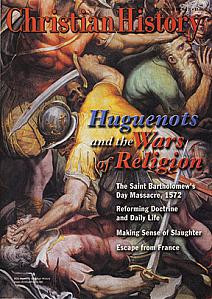Did French Royalty Plot The Huguenot Massacre?
DURING THE SIXTEENTH-CENTURY Reformation in Europe, Calvinism spread into France. The Roman Catholic establishment persecuted these Protestants, known as Huguenots. Led by French nobles, the Protestants rose to defend themselves. Three religious wars followed in quick succession. On 22 August 1572, Catherine de Medici tried to end the conflict with one blow by arranging the assassination of the Huguenot leader Admiral de Coligny.
Coligny survived the attempt and King Charles IX, Catherine’s son, promised him protection. Angry Huguenot leaders threatened to march on Paris. Infuriated, Catherine bent all her energy to convincing her son to massacre the Huguenot leaders. Late in the evening of this day 23 August 1572, Charles gave the order. In the early hours of 24 August, St. Bartholomew’s Day, the massacre began. Catholic historian Jacques-Auguste De Thou, son and grandson of French politicians and an eyewitness to some of the events, described what happened:
“Coligny awoke and recognized from the noise that a riot was taking place. Nevertheless he ... believed the populace had been stirred up by the Guises [a French ducal family opposed to the Huguenots], and that quiet would be restored as soon as it was seen that soldiers of the guard, under the command of Cosseins, had been detailed to protect him and guard his property.
“But when he perceived that the noise increased and that some one had fired an arquebus [an early muzzle-loading gun] in the courtyard of his dwelling, then at length, conjecturing what it might be, but too late, he arose from his bed and having put on his dressing gown he said his prayers, leaning against the wall.”
Swiss mercenaries entered his house and forced their way to his room. A German, who had been brought up in the home of the Duke of Guise, stabbed Coligny to death. The assassins threw his body from a window, then abused, mutilated, and decapitated the corpse.
Meanwhile an official named Marcel led the Catholic masses of Paris into the city, where they slaughtered Parisian Huguenots all that day. Massacres in outlying regions continued until 3 October. Perhaps seventy thousand Huguenots perished. Many fled to fortified cities and fought back. Huguenots called their movement La Cause (The Cause) and Catholics referred to themselves as La Sainte Ligue (The Holy League).
Although Charles IX took credit for ordering the massacre, most historians believe Catherine was the principle instigator. She had desired something like this for at least a decade and Philip II of Spain had also urged it. Following the massacre, the French court tried to spin the outrage as legitimate self-defense against a Huguenot plot; Pope Gregory XIII even struck a special medallion. In general, however, European nations were appalled.
France’s religious civil wars continued until King Henry IV issued the Edict of Nantes giving Huguenots a number of rights. Later kings eroded these until Louis XIV revoked the edict entirely in 1685. Hundreds of thousands of Huguenots (variously estimated between 100,000 and 800,000, probably nearer 200,000) then fled France, virtually extinguishing the ability of the remaining Huguenots to force significant political or religious reform.
—Dan Graves
----- ----- -----
For more, read Christian History #71 Huguenots and the Wars of Religion
Never miss an issue of Christian History. Subscribe now.






